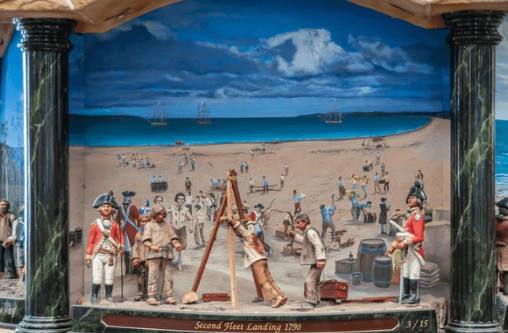Introduction: The Second Fleet’s Dark Legacy
Arrival of the Second Fleet: The Infamous Voyage That Shaped Early Australia – In 1790, the arrival of the Second Fleet at Port Jackson, New South Wales, marked a grim chapter in the early history of the British colony in Australia. Unlike the First Fleet, which had established the colony in 1788, the Second Fleet became infamous for its appalling conditions, the high mortality rate among the convicts, and the lasting impact it had on the fledgling settlement. This fleet, often referred to as the “Death Fleet,” underscored the harsh realities of convict transportation and the brutal treatment that many convicts endured during their journey to Australia.
The Second Fleet’s arrival had significant implications for the development of the colony. The state of the convicts who disembarked from these ships highlighted the dire need for better management and oversight of transportation practices. Moreover, the fleet’s impact on the colony’s population and resources played a crucial role in shaping the future of the settlement. This article explores the journey of the Second Fleet, the conditions aboard the ships, and the broader consequences for the colony and its inhabitants.
Read Also : The Smallpox Epidemic Among Indigenous Australians (1789): A Tragic Chapter in Early Colonial History
The Context of the Second Fleet: Britain’s Expanding Penal System
The arrival of the Second Fleet must be understood within the broader context of Britain’s penal system in the late 18th century. As Britain sought to deal with overcrowded prisons and the need to establish a sustainable colony in New South Wales, the transportation of convicts became a central strategy.
The Need for Reinforcements: Expanding the Colony
By 1790, the colony at Sydney Cove was struggling to survive. The settlers faced numerous challenges, including food shortages, poor soil, and a lack of skilled labor. The colony’s population consisted primarily of convicts, marines, and a few free settlers, and it had become clear that additional supplies and reinforcements were urgently needed to ensure the colony’s survival.
The British government, recognizing the colony’s precarious situation, decided to send a second fleet of ships to New South Wales. This fleet would carry not only additional convicts but also supplies, marines, and officers to bolster the struggling settlement. The arrival of these reinforcements was seen as essential to the colony’s continued existence and growth.
However, the decision to rely on private contractors to transport the convicts, rather than the Royal Navy, had significant consequences. The profit-driven motives of the contractors, combined with the lack of oversight, led to deplorable conditions on board the ships of the Second Fleet, ultimately resulting in a humanitarian disaster.
The Role of Private Contractors: Profits Over Lives
The transportation of convicts to Australia was a costly endeavor, and the British government sought to reduce expenses by contracting private companies to carry out the task. The Second Fleet was managed by the firm Camden, Calvert & King, which had been contracted to transport convicts to New South Wales.
Unfortunately, the profit-driven nature of the private contractors led to severe neglect and mistreatment of the convicts aboard the Second Fleet. The contractors were paid based on the number of convicts who boarded the ships in England, rather than those who arrived alive in Australia. As a result, there was little incentive to ensure the well-being of the convicts during the voyage.
The prioritization of profits over the lives of the convicts resulted in appalling conditions on board the ships. The overcrowded and unsanitary conditions, combined with inadequate food, water, and medical care, led to a high mortality rate and widespread suffering among the convicts. The tragic consequences of these conditions became evident upon the fleet’s arrival in Australia.
The Convicts of the Second Fleet: A Diverse and Desperate Group
The convicts transported on the Second Fleet represented a cross-section of British society’s marginalized and impoverished individuals. Many had been convicted of petty crimes, often driven by poverty and desperation. The convicts included men, women, and children, all sentenced to transportation as a form of punishment and exile.
The convicts on the Second Fleet were not only physically diverse but also varied in terms of their backgrounds and experiences. Some were repeat offenders, while others were first-time criminals. The harsh conditions aboard the ships and the brutal treatment they received further compounded the challenges these individuals faced upon their arrival in Australia.
The experience of the Second Fleet convicts highlights the broader social and economic inequalities in Britain at the time. The transportation of convicts to Australia was seen as a solution to the problem of overcrowded prisons, but it also reflected the broader issues of poverty, crime, and social injustice that characterized 18th-century Britain.
The Journey of the Second Fleet: A Voyage of Suffering
The journey of the Second Fleet from England to Australia was marked by extreme hardship and suffering. The conditions aboard the ships were dire, and the mortality rate among the convicts was alarmingly high. The fleet’s journey remains one of the darkest episodes in the history of convict transportation.
The Ships of the Second Fleet
The Second Fleet consisted of six ships: three convict transports, one supply ship, and two storeships. The convict transports were the Surprize, Neptune, and Scarborough, while the supply ship was the Justin, and the storeships were the Guardian and Lady Juliana. Each of these ships played a different role in the fleet, but all were integral to the overall mission of reinforcing the colony at Sydney Cove.
The convict transports were the most infamous of the ships, as they carried the bulk of the convicts who endured the horrific conditions of the voyage. The Neptune in particular became notorious for the cruelty and neglect exhibited by its crew, leading to an extraordinarily high death toll among the convicts.
The supply and storeships were tasked with carrying essential provisions, including food, clothing, tools, and other materials needed to sustain the colony. However, the loss of the Guardian in a shipwreck en route to Australia further exacerbated the colony’s challenges, as many of the supplies intended for the settlement were lost at sea.
Conditions Aboard the Ships: A Humanitarian Disaster
The conditions aboard the convict transports of the Second Fleet were appalling by any standard. The convicts were crammed into the hold of the ships, with little ventilation, light, or space to move. The overcrowded conditions, combined with the lack of sanitation, created a breeding ground for disease.
The convicts were given minimal food and water, often of poor quality, and were subjected to harsh treatment by the crew. Many were chained and confined to their berths for the duration of the voyage, leading to physical and psychological suffering. The lack of medical care meant that diseases such as scurvy, dysentery, and typhus spread rapidly among the convicts, resulting in a high mortality rate.
By the time the Second Fleet arrived in Port Jackson, approximately one-quarter of the convicts had died during the voyage, and many others were gravely ill. The survivors disembarked in a weakened and emaciated state, and the colony was immediately faced with the challenge of caring for these desperate and suffering individuals.
The Arrival in Port Jackson: A Grim Unveiling
The Second Fleet’s arrival in Port Jackson in June 1790 was met with horror and disbelief by the colony’s residents. The sight of the emaciated and sickly convicts, many of whom were near death, underscored the inhumanity of the conditions they had endured during the voyage.
Governor Arthur Phillip and other colonial officials were appalled by the state of the convicts and immediately launched an investigation into the circumstances of the voyage. The revelations of neglect, mistreatment, and the high death toll led to widespread outrage and condemnation, both within the colony and back in Britain.
The arrival of the Second Fleet had significant implications for the colony. The influx of sick and dying convicts placed an enormous strain on the colony’s limited resources, including food, medical supplies, and manpower. The already precarious situation in the settlement was further exacerbated by the need to care for the survivors and manage the aftermath of the fleet’s arrival.
The Consequences of the Second Fleet: Impact on the Colony
The arrival of the Second Fleet had far-reaching consequences for the colony of New South Wales. The immediate impact of the fleet was felt in terms of the strain on resources, the health crisis it precipitated, and the challenges of integrating the new arrivals into the colony. However, the long-term consequences of the fleet’s arrival also played a significant role in shaping the future of the settlement.
Strain on Resources and Survival
The colony at Sydney Cove was already struggling with limited resources when the Second Fleet arrived. The additional burden of caring for the sick and emaciated convicts placed immense pressure on the settlement’s food supplies, medical facilities, and workforce.
The loss of the Guardian, which had been carrying much-needed supplies, further compounded the challenges faced by the colony. The settlers were forced to implement strict rationing measures to ensure that the limited food supplies could be stretched to meet the needs of the entire population.
The strain on resources created by the Second Fleet’s arrival highlighted the ongoing challenges of sustaining the colony in a harsh and unfamiliar environment. The settlers were increasingly dependent on resupply from Britain and other sources, and the need to develop local agriculture and industry became more urgent.
Health Crisis and Medical Response
The health crisis precipitated by the Second Fleet’s arrival was one of the most immediate and pressing challenges faced by the colony. The sick and dying convicts required urgent medical care, but the colony’s limited medical facilities were quickly overwhelmed.
Governor Phillip and his officials took immediate action to address the health crisis, establishing makeshift hospitals and enlisting the help of the colony’s few medical practitioners. However, the lack of medical supplies and the severity of the convicts’ conditions meant that many did not survive, and those who did often faced long and difficult recoveries.
The health crisis also had broader implications for the colony’s workforce. The survivors of the Second Fleet, weakened by their ordeal, were often unable to work or contribute to the colony’s development for an extended period. This further slowed the progress of the settlement and underscored the need for additional support and resources.
Legal and Political Repercussions
The appalling conditions and high death toll aboard the Second Fleet led to significant legal and political repercussions, both in the colony and in Britain. The investigation launched by Governor Phillip revealed widespread neglect and mistreatment by the private contractors, leading to calls for greater oversight and accountability in the transportation of convicts.
In Britain, the revelations about the Second Fleet sparked public outrage and led to debates about the ethics of convict transportation. The British government faced increasing pressure to reform the system and to ensure that future convoys were better managed and more humane.
The Second Fleet’s arrival also had political implications within the colony. The challenges of integrating the new arrivals and managing the aftermath of the fleet’s arrival highlighted the need for stronger leadership and more effective governance. Governor Phillip’s handling of the crisis earned him both praise and criticism, and his experience with the Second Fleet would shape his approach to the colony’s future development.
The Long-Term Legacy of the Second Fleet
The long-term legacy of the Second Fleet is complex and multifaceted. While the fleet’s arrival was a humanitarian disaster, it also played a significant role in shaping the development of the colony of New South Wales and the broader history of Australia.
Shaping Convict Transportation Policy
The horrors of the Second Fleet had a lasting impact on British convict transportation policy. The outcry over the conditions aboard the fleet led to increased scrutiny of the transportation system and calls for reform. In response, the British government implemented changes aimed at improving the treatment of convicts during their journey to Australia.
These changes included stricter regulations for private contractors, greater oversight of the conditions aboard convict ships, and efforts to ensure that convicts received adequate food, water, and medical care during the voyage. While the system remained far from perfect, the lessons learned from the Second Fleet helped to prevent future transportation voyages from descending into similar disasters.
The experience of the Second Fleet also contributed to a broader shift in attitudes toward convict transportation. The British government began to recognize the importance of ensuring that convicts arrived in Australia in a condition that allowed them to contribute to the colony’s development, rather than being a burden on its resources.
The Impact on the Colony’s Growth and Development
The arrival of the Second Fleet had both immediate and long-term impacts on the growth and development of the colony of New South Wales. In the short term, the fleet’s arrival exacerbated the challenges faced by the colony, straining resources and creating a health crisis. However, in the long term, the influx of new convicts and supplies, despite the hardships, helped to bolster the colony’s population and workforce.
The survivors of the Second Fleet eventually became an integral part of the colony’s labor force, contributing to the construction of infrastructure, the development of agriculture, and the expansion of the settlement. The challenges they faced also fostered a sense of resilience and determination among the colonists, qualities that would become central to the emerging Australian identity.
The Second Fleet’s arrival also underscored the importance of developing local resources and reducing the colony’s dependence on resupply from Britain. The settlers began to focus more intently on establishing sustainable agriculture, building infrastructure, and expanding their territory, laying the groundwork for the colony’s future growth.
The Legacy in Australian Memory
The legacy of the Second Fleet is a somber one, remembered as a dark chapter in Australia’s early history. The fleet’s arrival is often contrasted with the more hopeful narrative of the First Fleet, highlighting the harsh realities of convict transportation and the suffering endured by those who were sent to Australia.
The story of the Second Fleet serves as a reminder of the complexities and challenges of Australia’s colonial past. It underscores the human cost of the British penal system and the difficult conditions faced by the early settlers as they sought to build a new society in an unfamiliar and often unforgiving land.
The legacy of the Second Fleet is also reflected in the broader narrative of Australia’s development as a nation. The resilience and determination of those who survived the journey and helped to build the colony are celebrated as defining characteristics of the Australian spirit, while the lessons learned from the fleet’s tragic voyage continue to inform discussions about justice, human rights, and the treatment of vulnerable populations.
Conclusion: Reflecting on the Arrival of the Second Fleet
The arrival of the Second Fleet at Port Jackson in 1790 stands as one of the most tragic and significant events in the early history of Australia. The fleet’s horrific conditions and high mortality rate revealed the brutal realities of convict transportation and highlighted the need for reform in the British penal system.
Despite the suffering endured by the convicts, the arrival of the Second Fleet also played a crucial role in the survival and growth of the colony of New South Wales. The challenges faced by the colonists in the wake of the fleet’s arrival helped to shape the development of the settlement and contributed to the resilience and determination that would come to define the Australian identity.
Reflecting on the history of the Second Fleet is essential for understanding the complexities of Australia’s colonial past. It serves as a reminder of the human cost of colonization and the importance of recognizing and addressing the injustices of the past as Australia continues to build a more just and inclusive society.
FAQ About the Arrival of the Second Fleet
What was the Second Fleet?
The Second Fleet was a group of six ships that arrived at Port Jackson, New South Wales, in 1790. It carried convicts, supplies, and marines to reinforce the struggling colony established by the First Fleet. The Second Fleet became infamous for the appalling conditions on board, leading to a high mortality rate among the convicts.
Why is the Second Fleet often called the “Death Fleet”?
The Second Fleet is often referred to as the “Death Fleet” because of the horrific conditions on board the convict ships. Overcrowding, poor sanitation, inadequate food, and brutal treatment by the crew led to the deaths of approximately one-quarter of the convicts during the voyage, earning the fleet its grim nickname.
What impact did the Second Fleet have on the colony of New South Wales?
The arrival of the Second Fleet had a significant impact on the colony of New South Wales. It strained the colony’s resources, created a health crisis, and highlighted the need for better management of convict transportation. Despite these challenges, the new arrivals eventually contributed to the colony’s growth and development.
How did the British government respond to the conditions of the Second Fleet?
The British government faced public outrage and criticism following the revelations about the conditions aboard the Second Fleet. The government implemented reforms to improve the treatment of convicts during transportation, including stricter oversight of private contractors and efforts to ensure better conditions on future voyages.
What is the legacy of the Second Fleet in Australian history?
The legacy of the Second Fleet is a complex and somber one. It is remembered as a dark chapter in Australia’s early history, highlighting the brutal realities of convict transportation and the human cost of colonization. The fleet’s arrival also played a crucial role in shaping the development of the colony and the resilience of the early settlers.







Thank you for your articles. http://www.hairstylesvip.com They are very helpful to me. Can you help me with something?
Howdy are using WordPress for your site platform?
I’m new to the blog world but I’m trying to get started and
set up my own. Do you need any html coding expertise to make your own blog?
Any help would be greatly appreciated! https://menbehealth.wordpress.com/
It’s actually a great annd helpfful piece oof information. I’m happy
that yyou simply shared this useful info with us. Please keep us informed like
this. Thanks for sharing. https://menbehealth.wordpress.com/
Wohh just what I was searching for, thankyou for posting.